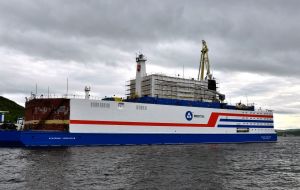MercoPress. South Atlantic News Agency
Nuclear generated electricity increases for seventh year running
 Six reactors started up in 2019: four large PWRs commenced operation, one in South Korea, one in Russia and two in China
Six reactors started up in 2019: four large PWRs commenced operation, one in South Korea, one in Russia and two in China  Two small reactors on the first purpose-built floating nuclear power plant, harbored at the town of Pevek in northeast Russia, started supplying electricity
Two small reactors on the first purpose-built floating nuclear power plant, harbored at the town of Pevek in northeast Russia, started supplying electricity Electricity generated from the world’s nuclear reactors increased for the seventh consecutive year in 2019, with electricity output reaching 2657 TWh. This was an increase of 95 TWh on the previous year, and the second-highest ever output, according to Agneta Rising, Director General of World Nuclear Association.
At the end of 2019 the capacity of the world’s 442 operable reactors was 392 GWe, down from 397 GWe at the end of the previous year. Thirteen reactors shut down, of which four were in Japan and had not generated electricity since 2011; and three, in South Korea, Germany and Taiwan, were shut prematurely due to political phase-out policies.
Six reactors started up in 2019. Four large PWRs commenced operation, one in South Korea, one in Russia and two in China. In addition, two small reactors on the first purpose-built floating nuclear power plant, harbored at the town of Pevek in northeast Russia, started supplying electricity. New construction began on five reactors, two in China and one each in Iran, Russia and the UK.
Given the reduction in overall nuclear capacity, the increase in generation in 2019 is all the more remarkable. However, there is an urgent need for the pace of grid connections and new construction starts to increase in order to expand the essential contribution nuclear energy makes to global clean energy provision and reach the nuclear industry’s Harmony goal.
The median construction time for reactors in 2019 was 117 months. As was the case in 2018, several of the reactors starting up in 2019 featured designs that were first-of-a-kind (FOAK). Construction times since 2015 have more typically been between five to six years. In August 2020 we saw the startup of Tianwan 5, after a construction period of 56 months, less than half the 2019 average; this is in part due to the benefits of experience gained through series construction. Even though the reactor is only the third of this specific design, it is a development of a design that was used for more than 20 different reactors. It is also partly the result of having an ongoing construction program that helps build and retain skills among the workforce. Where new reactors have been successfully deployed there needs to be a commitment to repeating that deployment through series build, to take advantage of the learning gained. Barakah 1, which started up in August 2020, will be followed by three more reactors that will benefit from the experience gained in starting the first unit.
In 2020 the nuclear industry has been an essential part of the response to the coronavirus pandemic. Despite the challenges of working in COVID-safe conditions, nuclear operators have ensured reactors have been available to provide electricity and grid stability. Reactor operators have also had to respond to the marked reductions in demand that have been observed during the pandemic and have had to operate with more flexibility. For these reasons it is likely that next year’s report will show a reduction in overall nuclear generation.
Looking forward, governments are considering at how to restart their economies and generate jobs, as well as how to meet their energy and environmental goals. Each new nuclear build project generates thousands of jobs and boosts the local economy, as well as contributes to our Harmony goal of a clean and reliable electricity mix.




Top Comments
Disclaimer & comment rulesCommenting for this story is now closed.
If you have a Facebook account, become a fan and comment on our Facebook Page!